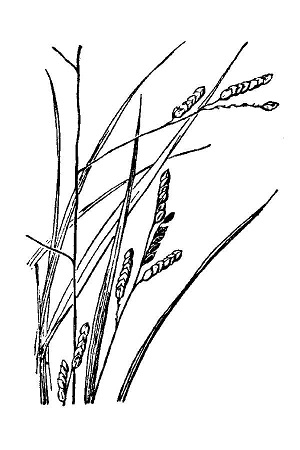
Copyright by: USDA-NRCS PLANTS Database / Hitchcock, A.S. (rev. A. Chase). 1950. Manual of the grasses of the United States. USDA Miscellaneous Publication No. 200. Washington, DC. (in the public domain)
Family: Poaceae
Group: Monocot
Substrate:
Terrestrial
Habit:
Herb
Perennation:
Perennial
Native Range: Southern United States (peninsular Florida, Texas), the West Indies and Mexico.
IRC SOUTH FLORIDA Status:
Presumed Extirpated or Extinct in the Wild
Map of select IRC data for peninsular Florida
SOUTH FLORIDA Occurrence:
Presumed Extirpated
SOUTH FLORIDA Native Status:
Native
South Florida History and Distribution: Ranked as presumed extirpated in Rare Plants of South Florida (
Gann et al. 2002; pp 82-83) based on several collections from 1838 to 1903 from Key West, Key Largo, the mouth of the Lostmans River in what is now Everglades National Park, and Buena Vista, just north of present day Miami. No new records are known.
SOUTH FLORIDA Cultivated Status:
Not Cultivated
Comments: This species is apparently extirpated in peninsular Florida (Gann et al. 2002). See also IRC’s report
Vascular plant species of management concern in Everglades National Park (Gann 2015, pp 147-149).
Synonyms:
Homalocenchrus monandrus.
FLORIDA KEYS Occurrence:
Presumed Extirpated
FLORIDA KEYS Native Status:
Presumed Extirpated
IRC FLORIDA KEYS Status:
Presumed Extirpated
Map of select IRC data for the Florida Keys
Florida Keys History and Distribution: First collected between 1838 and 1853 by John Loomis Blodgett on the island of Key West. Reported in
1913 by John Kunkel Small for low hammocks and limestone sinkholes from the upper Keys to the lower Keys, but L. monandra has only been collected on the island of Key West and on Key Largo. For more information on L. monandra, see IRC's
species account.
